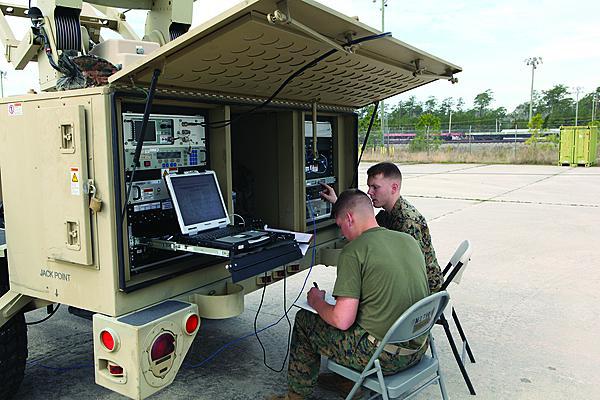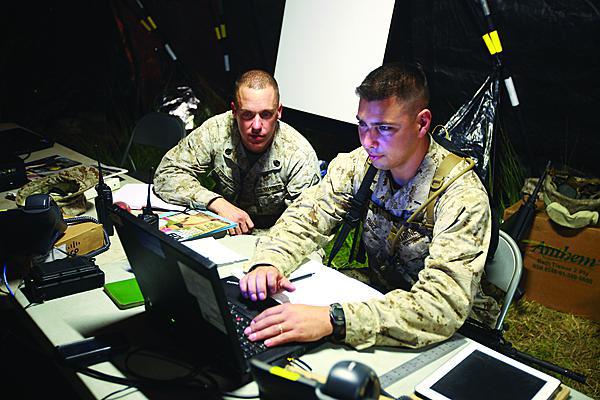Corps Blazes Ahead With Cloud Computing
As they put the necessary pieces in place, Marines are mindful of tight resources and are seeking help from industry.
For the past year, U.S. Marine Corps technical personnel have been implementing a strategy to develop a private cloud. The initiative supports the vision of the commandant while seeking to offer better services to troops in disadvantaged areas of the battlefield.
As part of this effort, members of the Headquarters Marine Corps (HQMC) Command, Control, Communications and Computers (C4) Department are working on enterprise licensing agreements with multiple vendors to achieve economies of scale. They also are examining thinning the environment as an element of infrastructure as a service, and they are exploring how an enterprise services support desk would support a cloud environment during the transition from a continuity of services contract to a government-owned, government-operated scenario. In place is a 600-day transition plan to help move from the former to the latter. Robert Anderson, chief, Vision and Strategy Division, HQMC C4, explains that the May 2012 “Marine Corps Private Cloud Computing Environment Strategy” serves as the driving document for the transition, and now Marines are trying to reach the point where they execute the requirements outlined in the paper. “There are multiple pieces that have to occur for this to happen,” he states. Personnel are working on follow-up documents now, including a mobility strategy and a five-year transition plan scheduled for release in June. The latter lays out the next steps for the cloud environment.
Through the efforts, C4 personnel are putting in place a plan of action from the headquarters level while corroborating with and aiming to enable the missions of Marine Corps Systems Command (MARCORSYSCOM), the Marine Corps Network Operations Center and the Marine Air-Ground Task Forces. Jeremy Cucco, information systems technical lead at MARCORSYSCOM, shares that “We are working on developing the actual cloud environment.” Personnel collaborate with programs of record and data centers to produce the right solutions. According to the strategy document, Marines are implementing the environment “with the intent of alignment of its enterprise processes to programs of record and ensuring technical solutions are mission oriented and geographically informed.”
The Marine Corps Enterprise Information Technology Services (MCEITS) is the basic enabler for this private cloud. The MCEITS establishes the Corps’ guidance for synchronizing current Marine information technology programs, according to the document.
Working with official programs is critical for private cloud computing environment (PCCE) developers because there is no funding dedicated to the work. Instead, they need to find resources from within programs’ baseline dollars. No money has been spent on hardware for the PCCE up to this point. And any time priorities compete for funding, the money will be diverted to Marines in harm’s way, so finding economical solutions is imperative for the future of the environment.
Several challenges must be overcome to make the PCCE a reality. The first and foremost, according to Cucco, is the lack of comprehension about what cloud computing is. He and his colleagues are working to share a common understanding with necessary parties. The Marines’ cloud strategy is based on the National Institute of Standards and Technology Definition of Cloud Computing and the Federal Cloud Computing Strategy. Another issue is identifying the path ahead in a field without lessons learned or past actions. “This is really new territory ... We don’t have any way to go to industry and say ‘Tell us your best practices. Tell us your lessons learned,’” Cucco states. So officials are trying to gain a better understanding of how to develop a cloud environment that is secure and effective.
The Marines Corps has established a cloud laboratory to develop its private cloud environment further. The laboratory is a collaborative effort among several Corps technical organizations and is located at Camp Pendleton, California. It takes advantage of existing resources, including software licenses. “The intent is to leverage the existing hardware, software, infrastructure and intellectual capital in which we’ve already invested to develop the baseline capabilities of infrastructure as a service, platform as a service and software as a service, rapidly,” Cucco says.
The MCEITS program will use detailed information coming out of the laboratory and transition capabilities into the enterprise environment. The laboratory is building off the existing hardware and software baseline used in the MCEITS environment and will work with other Marine Corps programs of record to begin to transition apps and capabilities into a virtualized, cloud environment. Personnel designed the schedule to be cognizant of activities within MCEITS to ensure alignment with the transition times and capabilities.
At the headquarters level, other progress is being made in baby steps to ensure all the pieces are in place. One issue from an engineering perspective is the Marine Corps’ active directory, which Anderson says is enormous. Developers have to coordinate among multiple groups and create an operational directive that dictates the change to the active directory environment. Many pieces of the overall enterprise rely on the directory, including access controls and public key infrastructure integration. Controlling access to data in the cloud is critical. “That’s a big deal,” Anderson states. “We don’t want people to access what they’re not supposed to.”
Officials also need to determine how to support the enterprise environment sufficiently during the transition to the government-owned, government-operated environment. Anderson says the network has to be federated in such a way that it can integrate seamlessly with the Joint Information Environment (JIE) when that comes online. The JIE is a Defense Department effort to create a common architecture among the military services’ networks, resulting in better information sharing and enabling enhanced mobile services.
One of the main tasks for the personnel involved with the PCCE is integration. Basic elements of the technology already exist, but they are not combined into the private cloud construct. Cucco says the issue is less of a technical challenge than a process one. However, he believes the Marines are on a good track to accomplish their private cloud goals and says both the Navy and the Defense Department recognize that the Corps is ahead of the curve in implementing this technology for warfighters.
Although the Marines are developing the PCCE within guidance from other government directives, they are not compromising their needs to go along with other groups. As Anderson explains, “The commandant is going to maintain his network. The commandant is going to maintain access to his data.” The job of communicators then is to enable these plans, which can separate the Corps’ efforts from other military services. “When the commandant says do something, that’s what we do,” Anderson states. “We carry out the commandant’s intent no matter what.”
The differences in how the military services operate and implement their technology now will carry over into the development of cloud environments. At the enterprise level, the branches share some practices; at the distributed level differences become more apparent; and at the tactical level, Cucco says, “it’s a different planet.” How and where Marines operate, often in environments more austere than their uniformed partners, means providing cloud services at the tactical level has unique challenges.
Fortunately, as project personnel work through the issues, they have support at all echelons. Regardless of rank, the Marines have embraced the PCCE as a necessity and as the path forward. The strategy document attracted attention from across the Corps up to the headquarters level and received more than 200 comments.
Once the environment is in place, it should bring multiple benefits to users, including standardizing practices across the Marine Corps Enterprise Network. After that, developers will know better what to build to increase capabilities. As the use of mobile technologies expands, baseline standards will allow mobile access to data and information regardless of location—an important consideration for expeditionary forces.
With the PCCE, Marines expect more agility with software and application development. A common complaint among the wider defense technical community is the speed at which new technologies are procured. Often, information technology is acquired with the same methods used for large vehicle platforms, then officials try to keep it up and operating for as long as possible. With the private cloud, the Marine Corps aims to have a more flexible development environment that ensures constant response to changing requirements. When a capability is past its usefulness, the Marines do not want to keep it running on a lifeline, but instead want to ensure systems perform as designed.
As with most military technical efforts, industry involvement can play a key role in the PCCE. Anderson says he is trying to create a cooperative research and development agreement, or CRADA, to increase collaboration with the private sector. He wants to answer, “How do we get data from an enterprise perspective that’s relevant to a tactical area of operations quickly?”
Anderson would like to see the cloud environment provide pertinent data to Marines in certain geographic areas. So if Marines go into the Horn of Africa, for example, and other government organizations host information applicable to threats there, the cloud could provide differential updates when new threats evolve. This setup would provide more timely information while reducing draws on bandwidth to reach back to data sources in other places. Anderson believes industry can help most with identifying data by sites and determining effective reachback capabilities.
By finding a vehicle to support those needs, the Marines can free up bandwidth for other critical functions such as command and control, intelligence, surveillance and reconnaissance, or fires. Anderson draws from his own experience deploying to Somalia in 1991, where he and his team had to scramble just to find maps. He would like the cloud environment to provide a way to download not only that sort of data, but also information about bad actors or tactics, techniques and procedures. He is unsure about how all the technology would work. “That’s why I’m asking industry for help,” Anderson explains. He also references the mobility construct, expressing the desire to have such resources available on a small pocket device.
Another area where industry can find opportunity is in virtual devices. Anderson says he often asks companies for advice on how to move the Marines’ chief information officer organization in that direction, but rarely receives feedback about how groups migrated themselves into a cloud environment. What does come in often is only a sales pitch, which officials recognize, but they need to move forward at minimal cost.
Cucco explains that what the Marine Corps needs from industry are the right solutions. “Just because it’s cool doesn’t mean it’s right for us,” he states. Capabilities need to provide functionality and save money. The Corps is interested in the “bring your own device” concept and wants information from industry about how to segregate pieces to ensure security.





Comments